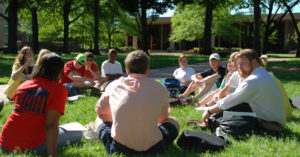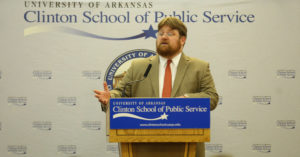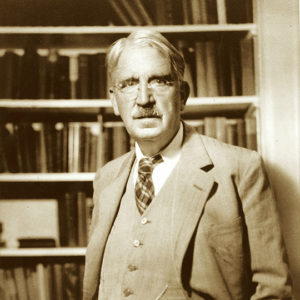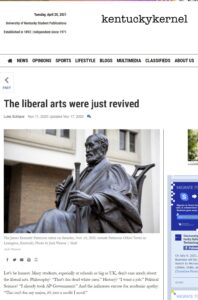Let’s say that a religion consists of beliefs–and, often, practices–that many people consider deeply important and that unite them as a community.
By this definition (derived from Durkheim), communism and some forms of patriotism may be religions, but there is no such thing as a solitaire religion. For one thing, most believers value unity and belonging. In the Abrahamic faiths, professions of faith are singular (“I accept Jesus as my personal savior …”), and an adherent could prefer–or be forced–to worship alone. Nevertheless, the basis of an Abrahamic religion is a revelation made to a group of people who formed a community when they accepted the revealed truths. To believe is to join that community. In other traditions, it may make even less sense to be a solo believer.
Finally, many religions claim–to various degrees–to be comprehensive and final. They offer conclusive answers to all the most important questions. This feature helps them to unify their believers and to occupy a major portion of their adherents’ inner lives.
In contrast, let’s call a philosophy a list of beliefs–and the relations among them–that a person arrives at by reflection. One’s reflection need not be rational as opposed to emotional, but it is personal. Everyone can arrive at a different philosophy. If we are wise, we assume that the beliefs on our own list are provisional and incomplete. When we bring our ideas into a public space, we expect disagreement, which may sometimes cause us to adjust our ideas.
By these definitions, a specific belief may play an important role within one or more religions and also one or many philosophies. The belief has the same content but a different function.
Over its long history, Buddhism has been a philosophy for many and a religion for many more. Ideas attributed to the Buddha and his influential followers have served to define and unite believers and have been deeply interwoven with other aspects of the believers’ shared cultures, such as their art, music, and ritual. In that sense, we can talk about Tibetan Buddhism or Buddhist architecture–cultural categories.
Meanwhile, individuals from diverse backgrounds have sometimes assessed ideas from Buddhism and have adopted one or more of them into their own thinking, often in an eclectic fashion, without considering them complete or final, and without necessarily feeling any sense of belonging. The latter is Buddhism as philosophy.
The philosophical approach involves assessing each belief associated with Buddhism, asking whether it coheres with your own experience and your previous reflections and with the other ideas on the list of Buddhist beliefs. This process actually requires a prior step: deciding which ideas are important to Buddhism–a sensitive task, given the variety of views held over more than two millennia of development. The outcome is a list of zero or more ideas that you feel you should provisionally endorse, along with any the other ideas from any other sources that you also hold. For example, I would ask whether each Buddhist idea coheres with major findings of 21st century natural science.
By the way, there is some textual evidence that this is how the Buddha wanted to be received, although I don’t know whether that evidence is historically valid. In any case, I would start the philosophical analysis with the Four Noble Truths, which are fundamental across the whole tradition.
The first is the truth of suffering. It is not wrong to try to phrase this as a proposition, in which case some candidates might be: “Suffering is inevitable,” or “Suffering is universal,” or “Suffering is intrinsic to life.” You can also consider which propositions are incompatible with it, such as “Everything happens for a good reason and works out well in the end,” or “Only people who deserve to suffer ultimately experience suffering.” Buddhism rejects such claims.
But there is a good reason that the noble truths are not usually presented as propositions. To endorse the first noble truth is to feel the significance and ubiquity of suffering: not only one’s own but also everyone else’s. The truth is closely connected to the mental state of compassion. To endorse it is to be compassionate, and vice-versa. The philosophical question, then, is whether such universal compassion is virtuous and valid.
The second noble truth is the truth of the origin of suffering. Spelled out in propositional form, the origin is said to be craving, desire, or attachment (tanha). This is certainly a claim that one can reason about. Does desire inevitably yield suffering? If so, why? Is the reason metaphysical, or is it a feature of human psychology? What kind of emotion (or action?) qualifies as tanha? These are issues within Buddhist philosophy and worthy of inquiry. But, again, the second truth is not typically phrased as a proposition because it is equally important to try it out. Does it seem right that craving, or clinging, or some such emotional state is involved (often or always) in the suffering that one feels and observes?
The third truth is the truth of the cessation of suffering. Removing the cause, which is craving, will remove the suffering itself. This claim is philosophically contestable. Assuming that craving does cause suffering, are we confident that ceasing to crave will remedy the damage already done? Is a life without craving and without suffering a good life? Is it the best life? Again, I think these are questions within Buddhism, not critical of the tradition.
The fourth truth is the path to the cessation of suffering. In medical terms, we have already explored the condition (suffering), the diagnosis (craving), and the cure (ceasing to crave). We need a prescription to accomplish the cure. The prescription is a set of right actions and right thoughts, often spelled out in detail. The specific content is contested and has varied within the tradition, but we can identify some typical elements.
First, right action is moderate. It is the Buddha’s “middle way” between asceticism and self-indulgence. You can’t remove the cause of suffering either by rejecting all pleasurable experiences or by filling your stream of experience with pleasure. You are wiser to put temporary pleasures in their proper place within a life that is ordered and responsible and attainable by actual human beings. By filling your life with this kind of moderation, you occupy time that would otherwise be colonized by immoderate will, which would worsen suffering.
Second, right action helps other sentient beings but without ignoring the actor’s condition. In Owen Flanagan’s phrase, the ideal is “equanimity-in-community.” By being a helpful part of a community while also tending to one’s own mental equilibrium, one fills the time that would otherwise be occupied with indulgence or asceticism, which would worsen suffering. This balance between individual and community complements the moderation of the middle way.
Third, right thinking (and right action) must be consistent with the noble truths. To start with, the first truth implies–or actually is–compassion; therefore, good thought and action must be compassionate. The more mental space we occupy with compassion, the less will fill with craving. The desire that others escape suffering has the unique feature of not causing the desirer to suffer. And if we are truly compassionate, we must act in others’ benefit. Emotion and action come together.
Fourth, right thinking reflects correct metaphysics, which has at least two important features.
The doctrine of no-self holds that there is no autonomous, durable (let alone immortal) self, the kind of thing that might be labeled a “soul” in other traditions. Introspection identifies many specific thoughts and experiences that arrive in a rapid flow. It does not ever identify the self that “has” these experiences, because there is no such thing. Per the second noble truth, the impulse to find a self and to preserve it amid the flux is a form of craving that inevitably yields suffering. Really believing the doctrine of no-self helps to accomplish the cure promised in the fourth truth. Apart from anything else, it makes one much less concerned about oneself, thus leaving more space for compassion.
The doctrine of dependent origination holds that everything happens as the inevitable outcome of the conditions that were in place before it. This is very much like a core metaphysical assumption of modern science. It rejects the notion of a “final” cause (in Aristotle’s sense). Things do not happen because of some independent end or purpose. For instance, I may believe I am raising my hand in order to get attention, but the real cause is the firing of neurons, which happens because of prior neurons’ firing and other physical circumstances. A related doctrine is impermanence: everything inevitably changes.
We should believe in dependent origination and impermanence because they are true and also because they help us on the path from suffering. Believing in final causes–that things happen for good reasons–and in permanent objects of value causes frustration because we constantly observe bad outcomes and change. Instead, we should acknowledge that things just happen. That includes suffering, which arises because of prior conditions, but especially because of prior expressions of craving. Compassionate action interrupts that causal cycle.
What about two famous doctrines that seem much less compatible with modern science and with the moral experiences of modernity: reincarnation and karma?
One way to interpret these ideas would be as background assumptions from the cultural milieu of the Buddha and his South Asian followers. Other Indian traditions also teach karma and reincarnation. In the Mediterranean region, the comparable background assumptions were the survival of the soul after bodily death and the existence of an afterlife. We don’t find it especially interesting when an ancient Mediterranean thinker assumes that souls go to the underworld. We could likewise attribute karma and reincarnation to the cultural milieu and not take these ideas seriously as core ideas of Buddhism–much as we might dismiss the classical Buddhist list of four elements (earth, air, fire, and water), which they shared with Mediterranean peoples. To be a Buddhist today does not imply belief in the four elements, and maybe it doesn’t imply karma and reincarnation.
A different response has the advantage of being more interesting. After all, the popular summaries of both karma and reincarnation contradict major points summarized earlier in this post. If there is no-self, how can the soul transmigrate to a different body after death? And if everything happens through dependent origination, why should good actions always yield benefits to the person who acts well? Why would the universe be set up so nicely?
Perhaps we should revise these doctrines to make them more compatible with the rest of Buddhist thought. In fact, the best any of us can do is to adopt the background material of a culture and revise it in the light of our own best thinking to create a framework that illuminates something about the reality of an existence that is too complex for human beings to grasp in full. In that spirit, let’s reconstruct what a believer in the four noble truths, no-self, and dependent origination would make of reincarnation and karma.
I think reincarnation becomes a doctrine of continuous rebirth. There is no self, just a stream of experiences. In that sense, the self is constantly being reincarnated. Furthermore, most of our experiences are not original to us. We feel things that others have felt before and that still others will feel after we are gone. Even the words we inwardly use to name these experiences belong to languages spoken before and after our time. Thus the components of our experience travel from organism to organism, and the process of rebirth outlasts the natural lives of individuals. This theory is but crudely expressed by the literal idea of reincarnation.
And I think karma gains an ethical gloss. It is not that some cosmic scorekeeper gives us positive points for good behavior and demerit points for bad behavior and calibrates our suffering accordingly (in our current and future lives). We are not literally paying the price for bad actions that we performed in past lives, for there is no self that carries over from yesterday to today, let alone from one death to another. Rather, there is a tendency for craving to cause suffering and for compassionate thoughts and acts to reduce it. Craving is like any other factor in a deterministic world of cause-and-effect: its influence tends to ripple out and affect other people. The best way to block it is to exercise compassion instead. Ideally, that will radiate out positively. In this sense, each of us experiences the total of the good and bad karma of many past lives. There is, however, no one-to-one correspondence between a specific past life and a specific current one.
If these glosses are correct, why are they not communicated more clearly and prominently, at the expense of the literal versions of karma and reincarnation? Here the “three vehicles” idea from Mahayana Buddhism is helpful. We can reduce suffering in several different ways, and any way that works is valuable. If it helps to believe that every bad action accrues to the actor and causes suffering later on–in the next life if not in this life–then that is a welcome result. One who believes this theory will strive to be compassionate and will thus tend to suffer less. However, this theory isn’t Really True. You might instead believe that everyone should be compassionate for its own sake even though the outcomes are uncontrollable and determined. This theory has the advantage of being more philosophically defensible, but it is not very inspiring–except for the wisest among us. So people need a choice of vehicles that they can ride on the path away from suffering.
None of this is meant to be original–it just represents my personal effort to explore some aspects of Buddhism as philosophy. If it has any value, it is as an example of a worthwhile exercise.
It is not final. I assent to several of the Buddhist theories because of my other experiences and my commitment to contemporary science, but experiences and scientific findings change. Also, I did not discuss in any detail my skepticism about some of the theories.
It is not comprehensive. What I have written here says nothing about political institutions or social justice, epistemology, or aesthetics. It is all about ethics and metaphysics (and incomplete on those topics). Of course, thinkers who identify as Buddhists have developed political, epistemological, and aesthetic ideas, but that doesn’t mean that their ideas are implied by the core tenets of Buddhism. If we treat Buddhist ideas as philosophical, we would expect any list to be incomplete and for specific ideas to appear in various philosophical structures that also draw on other sources. Comprehensiveness is impossible.
Finally, the result is not redemptive or salvific. The advice may be good, and you may tend to benefit if you follow it, but you will not be able to honor it completely enough to banish suffering. (It is said that the Buddha experienced headaches even after his enlightenment.) On the other hand, it is possible to envision a person who has followed these principles thoroughly enough to have overcome existential dread. That requires no suspension of the usual physical or metaphysical rules. It is a psychological accomplishment, and it offers as much consolation as one would derive from the news that there was a life after death.
See also: the grammar of the four Noble Truths; freedom of the will or freedom from the will? (comparing Harry Frankfurt and Buddhism); how to think about other people’s interests: Rawls, Buddhism, and empathy; Owen Flanagan, The Bodhisattva’s Brain: Buddhism Naturalized; scholasticism in global context; what secular people can get out of theology; how to think about the self (Buddhist and Kantian perspectives); rebirth without metaphysics; is everyone religious?, three truths and a question about happiness; etc.






